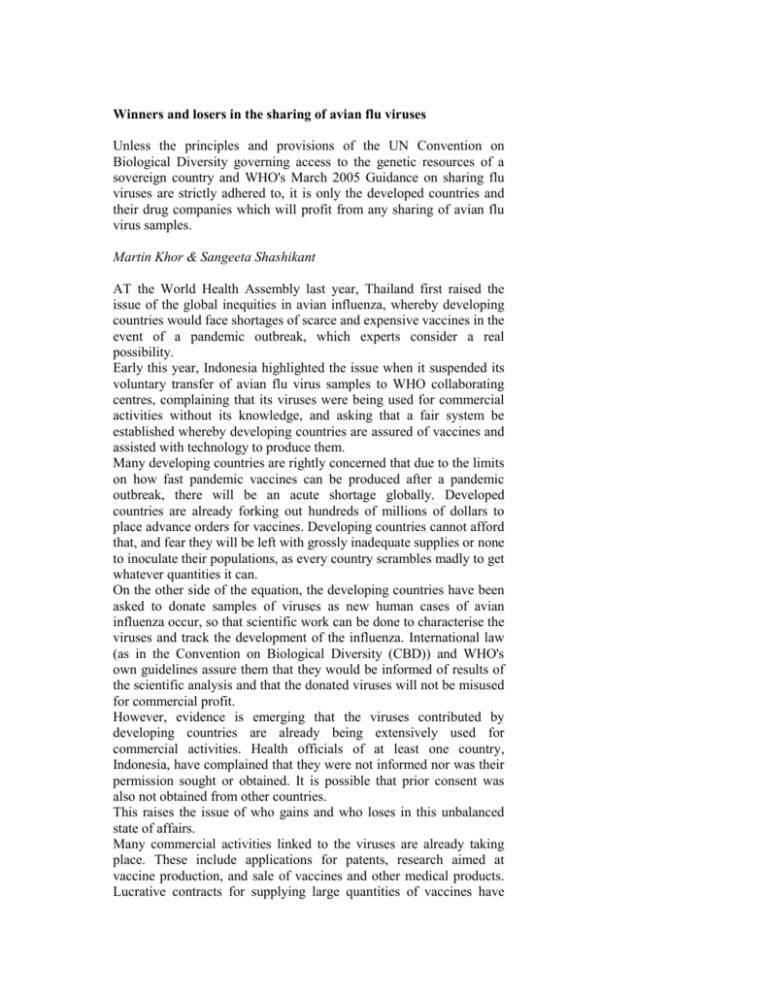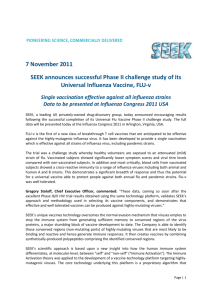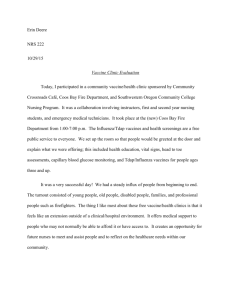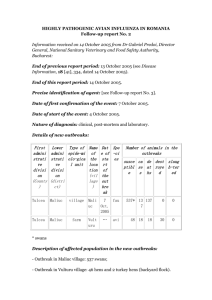Winners and losers in the sharing of avian flu
advertisement

Winners and losers in the sharing of avian flu viruses Unless the principles and provisions of the UN Convention on Biological Diversity governing access to the genetic resources of a sovereign country and WHO's March 2005 Guidance on sharing flu viruses are strictly adhered to, it is only the developed countries and their drug companies which will profit from any sharing of avian flu virus samples. Martin Khor & Sangeeta Shashikant AT the World Health Assembly last year, Thailand first raised the issue of the global inequities in avian influenza, whereby developing countries would face shortages of scarce and expensive vaccines in the event of a pandemic outbreak, which experts consider a real possibility. Early this year, Indonesia highlighted the issue when it suspended its voluntary transfer of avian flu virus samples to WHO collaborating centres, complaining that its viruses were being used for commercial activities without its knowledge, and asking that a fair system be established whereby developing countries are assured of vaccines and assisted with technology to produce them. Many developing countries are rightly concerned that due to the limits on how fast pandemic vaccines can be produced after a pandemic outbreak, there will be an acute shortage globally. Developed countries are already forking out hundreds of millions of dollars to place advance orders for vaccines. Developing countries cannot afford that, and fear they will be left with grossly inadequate supplies or none to inoculate their populations, as every country scrambles madly to get whatever quantities it can. On the other side of the equation, the developing countries have been asked to donate samples of viruses as new human cases of avian influenza occur, so that scientific work can be done to characterise the viruses and track the development of the influenza. International law (as in the Convention on Biological Diversity (CBD)) and WHO's own guidelines assure them that they would be informed of results of the scientific analysis and that the donated viruses will not be misused for commercial profit. However, evidence is emerging that the viruses contributed by developing countries are already being extensively used for commercial activities. Health officials of at least one country, Indonesia, have complained that they were not informed nor was their permission sought or obtained. It is possible that prior consent was also not obtained from other countries. This raises the issue of who gains and who loses in this unbalanced state of affairs. Many commercial activities linked to the viruses are already taking place. These include applications for patents, research aimed at vaccine production, and sale of vaccines and other medical products. Lucrative contracts for supplying large quantities of vaccines have already been signed between drug companies and many developed countries. If the Convention on Biological Diversity's principles and provisions (which establish sovereign rights of a country to its genetic resources, prior informed consent and benefit-sharing) are adhered to, and if WHO's March 2005 Guidance on sharing flu viruses is followed, the country of origin of the virus has rights in determining access to the virus, and therefore conditions for access including benefit-sharing arrangements. WHO's Guidance specifies that viruses should be shared by affected countries with WHO centres and reference laboratories in order to prepare a response to a flu epidemic. The principles include that the WHO reference labs will seek permission from the originating country/lab to co-author and/or publish results obtained from the analyses of viruses; and that there will be no further distribution of viruses/specimens outside the network of WHO reference labs without permission from the originating country/lab. However, patent applications and vaccine sales have been taking place following the issuance of the March 2005 Guidance. Applications for patents could include patents for the gene sequence (or part of it) of the virus; patents of a gene sequence of a virus that has been genetically engineered, using part of the sequence of the original virus; patenting of research or production techniques that make use of the virus or its parts; patenting of the vaccine or other products that make use of the virus and its genetic materials. Patenting can have various effects. For example, if the gene sequence (or parts of it) of the virus is patented, this may create problems for others who want to research into or make products containing the gene sequence or parts of it. The patenting of techniques can hinder research or the development of the product. Patenting the final product can raise the cost of vaccines, making it unaffordable especially in developing countries. Patents are being applied for pandemic flu vaccines, which make use of parts of the gene sequences from viruses sent by countries with an outbreak to the WHO centres. One patent application in the US was even filed by a WHO collaborating centre, to patent modified influenza virus that includes genes from a Vietnam influenza virus. Other patent applications for vaccines involving parts of flu virus strains have been made by universities in the US and by companies. There are also patent applications for techniques used in research and production. A search on patent applications relevant to H5N1 influenza vaccines, and which make use of parts of the avian flu viruses, found the following examples: - An application for a US patent by Hawaii Biotech Inc (US) for an influenza recombinant subunit vaccine. This application, published in February 2007, claims a new type of influenza vaccine and specific H5N1 vaccines made with the technology. It specifically makes patent claims on genetic sequences from an influenza virus isolated in Indonesia in 2005 (A/Indonesia/5/05) and another isolated in China in 1997 (A/Hong Kong/156/97). - An application for a US patent by St. Jude's Children's Hospital (US), which is a WHO collaborating centre, for a modified influenza virus for monitoring and improving vaccine efficiency. This application, published in February 2007, makes claims on small changes to influenza HA genes, intended to strengthen the immune system reaction to the genetically engineered virus. It makes patent claims on any influenza HA gene modified in a certain way and also specifically claims the modified HA gene from an influenza virus isolated in Vietnam in 2004 (A/Vietnam/1203/04). - An application for a US patent by the University of Pittsburgh (US), for vaccines for the rapid response to pandemic avian influenza. This application, published in January 2007, claims new human and animal influenza vaccines based on (theoretically) replication-deficient adenoviruses. These genetically engineered vaccines incorporate genetic sequences from H5N1 viruses. This application claims pieces of any influenza HA gene used in the adenovirus-based vaccine. It specifically makes claims on the HA gene from an influenza virus isolated in Vietnam in 2004 (A/Vietnam/1203/04). - An application for a patent in the US, European Union, Australia, Canada, by Medimmune Vaccines Inc. (US) and the US government for influenza hemagglutinin and neuraminidase variants. This patent application claims any influenza HA and NA gene modified and used in specific ways. The patent application specifically uses H5N1 types isolated in Vietnam and China as examples (A/Vietnam/1203/2004, A/Hong Kong/491/97, and A/Hong Kong/213/2003). - An application for a US patent by Noranax Inc. (US) for functional influenza virus-like particles (VLPs). This patent covers methods of producing VLPs from influenza viruses. For the VLP to be useful as a vaccine, it must be derived from a specific flu isolate, or a close relative, that it is intended to protect against. The patent application claims any such VLP. According to recent company statements, the patent application technology has been applied to generate VLPs from recent Indonesian influenza isolates, most likely the A/Indonesia/5/2005 strain recommended for vaccine development by WHO. The company says its patent claims cover this Indonesiaderived candidate vaccine. Patent applications in the above cases were also filed with the Patent Cooperation Treaty (which is linked to the World Intellectual Property Organisation), which helps facilitate applications in many countries that are a party to the treaty. Regarding commercially related activities, the international drug industry's federation in 2006 listed 31 R&D projects for avian pandemic flu vaccines being undertaken by drug companies, all of them from the US, European countries and Japan. The projects involve various avian flu virus strains, including H5N1 viruses from Vietnam and Hong Kong, and other virus strains from China, Panama, and Singapore. Several developed countries have been buying from drug companies and stockpiling large quantities of pre-pandemic vaccines, and have placed orders in advance for large quantities of pandemic vaccines in the event of a pandemic. According to its November 2006 press release, Sanofi Pasteur (the vaccines business of the Sanofi-Aventis Group) signed a $117.9 million contract with the US Department of Health and Human Services (HHS) for the production of bulk concentrate of a new type of H5N1 pre-pandemic vaccine. 'This contract covers clade 2 of H5N1 virus (A/Indonesia) for use in the US government stockpile. Previous stockpile contracts covered the clade 1 form of H5N1,' said the release, adding that the H5N1 clade 2 bulk material is being manufactured from a seed virus provided by the US Centres for Disease Control and Prevention (CDC, a WHO collaborating centre). (The press release explained that most of the viruses circulating during the past four years fall into two distinct clades. Clade 1 viruses circulated in Cambodia, Thailand and Vietnam and were responsible for human infections in those countries in 2004 and 2005. Clade 2 viruses circulated in birds in China and Indonesia in 2003-04 and spread westward to the Middle East, Europe and Africa.) Sanofi also stated it was awarded a contract by the French Ministry of Health to produce a 1.4-million-dose stockpile of the H5N1 candidate being studied by Sanofi. Under the agreement, Sanofi could also be called upon to provide enough vaccine to protect up to 28 million people in France in the event of a pandemic being declared, once the actual virus strain responsible is identified. Sanofi has also entered into agreements with Italy and Australia to supply vaccines in the event of a pandemic influenza outbreak, and has other agreements with the US government involving development of pandemic vaccine stockpiles, production of investigational doses and the development of cell-culture technology. In September 2004, the company signed a contract with HHS to produce two million doses of bulk vaccine derived from the H5N1 viral strain. The H5N1 vaccine will be manufactured from a seed virus provided by the National Institute of Allergy and Infectious Diseases (NIAID), part of the US National Institutes of Health (NIH). In September 2005, HHS awarded a $150 million contract to Sanofi Pasteur to produce a vaccine for the H5N1 influenza virus strain. In April 2007, Sanofi Aventis announced that the US Food and Drug Administration had approved for the first time in the US a vaccine against H5N1 avian influenza for use with humans. The approval was based on a clinical trial by NIAID, completed in 2005. According to a February 2007 paper by NIAID, 'The H5N1 reference virus (the strain used to produce the H5N1 vaccines for NIAID's clinical trials) was developed by researchers at St. Jude Children's Research Hospital' in the US. The seed virus for the production of the vaccine was derived from the A/Vietnam/2004 and all other genes were derived from the A/PR/8/34 virus, a laboratory strain. Another company, GlaxoSmithKline (GSK), entered into a supply contract with the Swiss Federal Office of Public Health for 8 million doses of GSK's H5N1 antigen influenza vaccine and its proprietary adjuvant for pre-pandemic use, according to a 23 October 2006 report in Medical News Today. According to the report, the order provides enough doses, one per head of the entire Swiss population, to help prepare the immune system against the threat of a human influenza. The contract also provides for an advance purchase agreement for 7.5 million doses of a GSK pandemic vaccine which will be manufactured once a pandemic strain is identified by WHO. On 12 March 2007, Medical News Today reported on GSK's announcement that clinical trial data from two new studies show that for the first time GSK's candidate pre-pandemic split antigen H5N1 vaccine, formulated with GSK's proprietary adjuvant system, provides a substantial level of cross-immunity against a 'drifted' (diverse) strain of H5N1. According to the report: 'In vivo data from the pre-clinical studies demonstrated that GSK's adjuvanted vaccine, containing the Vietnam H5N1 strain, was not only able to protect against challenge with the vaccine virus strain but it also provides 96% (22/23) cross-protection against a lethal challenge with the drifted Indonesia strain of H5N1, giving an additional boost to hopes that pre-pandemic vaccination is a viable strategy for inclusion in pandemic preparedness plans.' The report added that in May 2006, GSK received an HHS contract worth $274 million to develop cell-culture technology to speed the development of new cell culture-based seasonal and pandemic influenza vaccines, and to scale up its cell culture manufacturing capability; in November 2006 GSK received a $40 million initial order for bulk H5N1 antigen from HHS while in January 2007 GSK received from HHS a $63.3 million contract to develop antigensparing H5N1 pandemic influenza vaccines. On 4 January 2007, GSK entered into an Advance Purchase Agreement with the Danish government to supply its split candidate pandemic antigen and proprietary adjuvant once a pandemic has been declared. Another company Novavax Inc. is reported by Medical News Today (on 4 May 2007) as saying that it has received positive study results from a live virus challenge to ferrets inoculated with its pandemic influenza vaccine, paving the way for clinical trials this year. The report adds, 'In the study, ferrets were inoculated with the company's virus-like particle (VLP) vaccine made from an Indonesian strain of H5N1 avian influenza.' The ferrets were then challenged with live H5N1 virus, and all ferrets that received the Novavax vaccine survived. According to the study, ferrets that received Novavax's H5N1 vaccine not only were protected against the Indonesian strain of avian flu but also were cross-protected against a separate strain originating in Vietnam. One set of clear winners are the vaccine manufacturers which have already obtained many hundreds of million dollars' worth of contracts to supply pre-pandemic and pandemic vaccines from the developed countries. These countries are also giving several millions of dollars to the companies in grants and subsidies for research and development activities. The UPI news agency on 8 February 2007 reported on a business analysis that the global vaccine market is expected to top $10 billion in 2007 and $23.8 billion by 2012, with flu vaccines sales forecasted to grow to $14 billion by 2012. Influenza, HIV and cancer will be the biggest growth areas in the vaccine market, and 'the biggest growth in the flu-vaccine market will come in the area of vaccines for pandemics that could be caused by the H5N1 strain of bird flu,' added the report. The developed countries are the other set of winners as they are able to fork out the high cost of stockpiling pre-pandemic vaccines and to make advance bookings for pandemic vaccines. The scene is set for the rich to survive a global pandemic. Moreover, under the present WHO-organised scheme, the developing countries have become obliged to donate their avian influenza viruses to WHO collaborating centres and reference laboratories, which are located in the developed countries. The centres and laboratories have been passing on the viruses or the information contained in the viruses to other institutions, including companies, even if this is not in line with the CBD or the WHO Guidance. The companies and developed countries are making commercial use of the viruses as they wish. Meanwhile, the developing countries have so far not benefited from this scheme. They face potential astronomical bills should they wish to purchase vaccines in sufficient quantities to protect their populations. An influenza bulletin published by the US CDC provides a catalogue with prices for influenza vaccines licensed for use in the US for the 2005-2006 flu season, which shows that the prices range from $10 to $25 per dose. A Bloomberg news article of 6 April reported that 'Indonesians spend an average of $30 annually on health care, compared with $5,700 in the US, according to the World Health Report. Glaxo's flu vaccine costs $6 to $11 a shot in markets around the world, and receiving a flu shot from a doctor can cost as much as $59 in Jakarta.' With inadequate financial resources to purchase vaccines, developing countries will suffer the most in the event of a pandemic outbreak. As it is, they already suffer immense economic losses from having to cull poultry in areas of avian flu outbreaks. If a pandemic of the human version of avian flu emerges, the cost to life, economy and society in these countries could be of unimaginable proportions. This article is reproduced from the South-North Development Monitor (SUNS, No. 6249, 10 May 2007).








